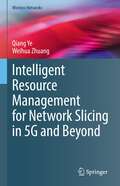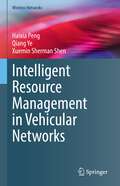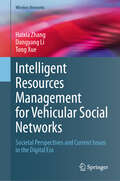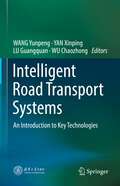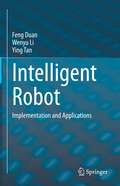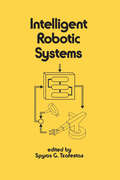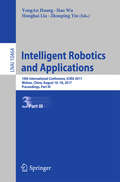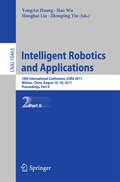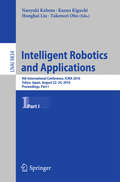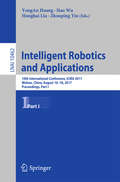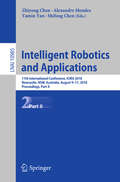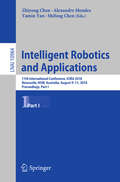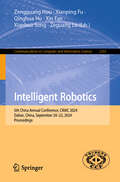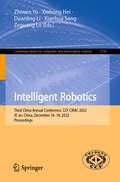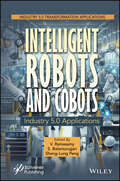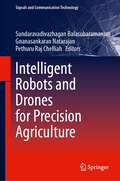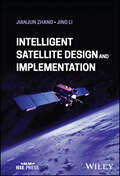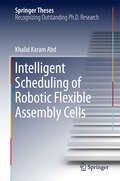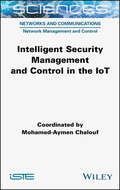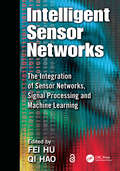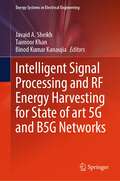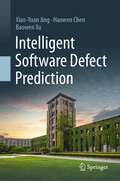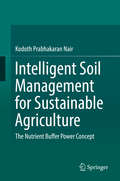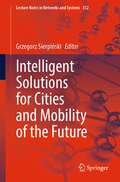- Table View
- List View
Intelligent Resource Management for Network Slicing in 5G and Beyond (Wireless Networks)
by Weihua Zhuang Qiang YeThis book provides a timely and comprehensive study of developing efficient network slicing frameworks in both 5G wireless and core networks. It also presents protocol stack layer perspectives, which includes virtual network topology design, end-to-end delay modeling, dynamic resource slicing, and link-layer and transport-layer protocol customization. This book provides basic principles, concepts and technologies for communication, computing and networking. Optimization and queueing analysis techniques are applied to solving different problems for network slicing illustrated in this book as well.Researchers working in the area of network slicing in 5G networks and beyond, and advanced-level students majoring in electrical engineering, computer engineering and computer science will find this book useful as a reference or secondary textbook. Professionals in industry seeking solutions to resource management for 5G networks and beyond will also want to purchase this book.
Intelligent Resource Management in Vehicular Networks (Wireless Networks)
by Xuemin Sherman Shen Qiang Ye Haixia PengThis book provides a comprehensive investigation on new technologies for future vehicular networks. The authors propose different schemes to efficiently manage the multi-dimensional resources for supporting diversified applications. The authors answer the questions of why connected and automated vehicle technology should be considered; how the multi-access edge computing (MEC) and unmanned aerial vehicle (UAV) technologies can be helpful to vehicular networks; how to efficiently manage the multi-dimensional resources to support different vehicular applications with guaranteed quality-of-service (QoS) requirements; and how to adopt optimization and AI technologies to achieve resource management in vehicular networks. The book is pertinent to researchers, professionals, academics and students in vehicular technologies.
Intelligent Resources Management for Vehicular Social Networks: Societal Perspectives and Current Issues in the Digital Era (Wireless Networks)
by Haixia Zhang Dongyang Li Tong XueThis book explores integrating behavior prediction with artificial intelligence-driven resource management to provide a transformative framework for optimizing vehicular social networks (VSNs). The book starts by providing an overview of the key issues encountered in VSNs, including the dynamic and unpredictable nature of vehicular mobility, varying communication demands, and the need for efficient resource allocation. A significant portion of the book is dedicated to exploring behavior prediction models for vehicles in VSNs. By analyzing the past movements, interactions, and social behaviors of vehicles, this book presents various prediction algorithms to anticipate future positions, communication patterns, and resource requirements. With behavior prediction as a foundation, the book delves into the design and implementation of intelligent resource management systems for VSNs. It demonstrates how predictive capabilities empower these systems to allocate communication, computing and caching resources dynamically. The book extensively evaluates the proposed intelligent resource management approach through extensive simulations and practical experiments. The results showcase the effectiveness of the system, highlighting significant improvements in network performance compared to traditional resource allocation methods. These findings validate the potential of behavior prediction and intelligent resource management in revolutionizing VSNs. Finally, this book provides conclusions and promising directions, hoping to stimulate future research outcomes in the field of vehicular networks from different perspectives. The book serves as an invaluable resource for researchers, engineers, and industry professionals interested in advancing the field of vehicular networks and harnessing behavior prediction to create efficient, safe, and intelligent VSNs.
Intelligent Road Transport Systems: An Introduction to Key Technologies
by Wang Yunpeng Yan Xinping Lu Guangquan Wu ChaozhongIn recent years, the application of intelligent transportation systems (ITS) has steadily expanded, and has become a hot spot of common interest to universities, scientific research institutes, enterprises and institutions in the transportation field. ITS is the product of the deep integration of modern high-tech in the transportation industry, and its development has accompanied that of modern high-tech. ITS is now also becoming part of the Internet of Things (IoT), and is expected to contribute significantly to making our cities smarter and connecting with other infrastructure. Although there are many monographs and textbooks on intelligent transportation, with the advancement of technology and changes in demand, the key technologies of ITS are also rapidly changing.This book chiefly focuses on the main technologies of ITS, examining them from four perspectives: “sense” (perception and management of traffic information, chapters 2 & 3), “transmission” (interaction of traffic information, chapter 4), “prediction” (prediction of traffic states, chapter 6) and “application” (intelligent transportation applications, chapters 6 through 10). Given its scope, the book can be used as a textbook for undergraduates or graduates, as well as a reference book for research institutes and enterprises.This book emphasizes the use of basis traffic engineering principles and state-of-art methodologies to develop functional designs. It largely reflects the authors’ own experience in adapting these methodologies to ITS design. For example, the book addresses various forms of data collection, models used to predict and evaluate traffic states, comprehensive description in connected vehicles, applications for users and traffic managers, etc. The knowledge gained here will allow designers to estimate the performance differences among alternatives and gauge their potential benefits for functional design purposes. To gain the most from the book, readers should be somewhat familiar with the field of traffic engineering and interested in ITS.
Intelligent Robot: Implementation and Applications
by Ying Tan Feng Duan Wenyu LiToday, the development of robots is making steady advances. In particular, the Robot Operating System (ROS) offers a unified platform that greatly facilitates the development of robots and has become a new hotspot for learning and application in the field of robotics research.This book introduces readers to the key technologies and development methods for ROS-based intelligent robots. Covering both the development history of robots and various aspects of programming robots, it offers effective support for beginners.The book is divided into three parts, the first of which introduces the basics of robots, including their definition, development, composition, and key technologies. In turn, the second part covers the hardware and software components and the implementation of functions such as vision, speech, grasping, and autonomous navigation. These functions need to work together to provide user-friendlier and more intelligent service. The third part shows how to develop robots with different functions in different application scenarios.Combining theoretical and practical aspects, with a strong focus on application, this work can be used as a reference book for robotics-related courses. Moreover, it will benefit all readers who are interested in intelligent robot development, sharing essential insights into developing service robots based on ROS.
Intelligent Robotic Systems
by Spyros G. TzafestasA multiplicity of techniques and angles of attack are incorporated in 18 contributions describing recent developments in the structure, architecture, programming, control, and implementation of industrial robots capable of performing intelligent action and decision making. Annotation copyright Book
Intelligent Robotics and Applications
by Honghai Liu Hao Wu Zhouping Yin Yongan HuangThese two volumes constitute the refereed proceedings of the First International Conference on Intelligent Robotics and Applications, ICIRA 2008, held in Wuhan, China, in October 2008. The 265 revised full papers presented were thoroughly reviewed and selected from 552 submissions; they are devoted but not limited to robot motion planning and manipulation; robot control; cognitive robotics; rehabilitation robotics; health care and artificial limb; robot learning; robot vision; human-machine interaction & coordination; mobile robotics; micro/nano mechanical systems; manufacturing automation; multi-axis surface machining; realworld applications.
Intelligent Robotics and Applications
by Honghai Liu Hao Wu Zhouping Yin Yongan HuangThese two volumes constitute the refereed proceedings of the First International Conference on Intelligent Robotics and Applications, ICIRA 2008, held in Wuhan, China, in October 2008. The 265 revised full papers presented were thoroughly reviewed and selected from 552 submissions; they are devoted but not limited to robot motion planning and manipulation; robot control; cognitive robotics; rehabilitation robotics; health care and artificial limb; robot learning; robot vision; human-machine interaction & coordination; mobile robotics; micro/nano mechanical systems; manufacturing automation; multi-axis surface machining; realworld applications.
Intelligent Robotics and Applications
by Honghai Liu Naoyuki Kubota Kazuo Kiguchi Takenori OboThe two volume set LNAI 7101 and LNAI 7102 constitutes the refereed proceedings of the 4th International Conference on Intelligent Robotics and Applications, ICIRA 2011, held in Aachen, Germany, in November 2011. The 122 revised full papers presented were thoroughly reviewed and selected from numerous submissions. They are organized in topical sections on progress in indoor UAV, robotics intelligence, industrial robots, rehabilitation robotics, mechanisms and their applications, multi robot systems, robot mechanism and design, parallel kinematics, parallel kinematics machines and parallel robotics, handling and manipulation, tangibility in human-machine interaction, navigation and localization of mobile robot, a body for the brain: embodied intelligence in bio-inspired robotics, intelligent visual systems, self-optimising production systems, computational intelligence, robot control systems, human-robot interaction, manipulators and applications, stability, dynamics and interpolation, evolutionary robotics, bio-inspired robotics, and image-processing applications.
Intelligent Robotics and Applications: 10th International Conference, Icira 2017, Wuhan, China, August 16-18, 2017. Proceedings, Part I (Lecture Notes in Computer Science #10462)
by Honghai Liu Hao Wu Zhouping Yin Yongan HuangThese two volumes constitute the refereed proceedings of the First International Conference on Intelligent Robotics and Applications, ICIRA 2008, held in Wuhan, China, in October 2008. The 265 revised full papers presented were thoroughly reviewed and selected from 552 submissions; they are devoted but not limited to robot motion planning and manipulation; robot control; cognitive robotics; rehabilitation robotics; health care and artificial limb; robot learning; robot vision; human-machine interaction & coordination; mobile robotics; micro/nano mechanical systems; manufacturing automation; multi-axis surface machining; realworld applications.
Intelligent Robotics and Applications: 11th International Conference, ICIRA 2018, Newcastle, NSW, Australia, August 9–11, 2018, Proceedings, Part II (Lecture Notes in Computer Science #10985)
by Zhiyong Chen Alexandre Mendes Yamin Yan Shifeng ChenThe two volume set LNAI 10984 and LNAI 10985 constitutes the refereed proceedings of the 11th International Conference on Intelligent Robotics and Applications, ICIRA 2018, held in Newcastle, NSW, Australia, in August 2018. The 81 papers presented in the two volumes were carefully reviewed and selected from 129 submissions. The papers in the first volume of the set are organized in topical sections on multi-agent systems and distributed control; human-machine interaction; rehabilitation robotics; sensors and actuators; and industrial robot and robot manufacturing. The papers in the second volume of the set are organized in topical sections on robot grasping and control; mobile robotics and path planning; robotic vision, recognition and reconstruction; and robot intelligence and learning.
Intelligent Robotics and Applications: 11th International Conference, Icira 2018, Newcastle, Nsw, Australia, August 9-11, 2018, Proceedings, Part Ii (Lecture Notes in Computer Science #10985)
by Zhiyong Chen Alexandre Mendes Yamin Yan Shifeng ChenThe two volume set LNAI 10984 and LNAI 10985 constitutes the refereed proceedings of the 11th International Conference on Intelligent Robotics and Applications, ICIRA 2018, held in Newcastle, NSW, Australia, in August 2018. The 81 papers presented in the two volumes were carefully reviewed and selected from 129 submissions. The papers in the first volume of the set are organized in topical sections on multi-agent systems and distributed control; human-machine interaction; rehabilitation robotics; sensors and actuators; and industrial robot and robot manufacturing. The papers in the second volume of the set are organized in topical sections on robot grasping and control; mobile robotics and path planning; robotic vision, recognition and reconstruction; and robot intelligence and learning.
Intelligent Robotics: 5th China Annual Conference, CIRAC 2024, Dalian, China, September 20–22, 2024, Proceedings (Communications in Computer and Information Science #2355)
by Xianhua Song Zeguang Lu Qinghua Hu Xin Fan Zengguang Hou Xianping FuThis book constitutes selected papers presented during the 5th China Annual Intelligent Robotics Conference, CIRAC 2024, held in Dalian, China, in September 2024. The 28 full papers presented in this volume were carefully reviewed and selected from 96 submissions. They are grouped into the following topics: Deep Learning Architecture; Low-Level Vision; Multi-modal learning; Pattern Recognition; Robotics; and Signal processing.
Intelligent Robotics: Third China Annual Conference, CCF CIRAC 2022, Xi’an, China, December 16–18, 2022, Proceedings (Communications in Computer and Information Science #1770)
by Xianhua Song Zeguang Lu Zhiwen Yu Xinhong Hei Duanling LiThis book constitutes selected papers presented during the Third China Annual Intelligent Robotics Conference, CCF CIRAC 2022, held in Xi' an, China, in December 2022. The 35 papers presented were thoroughly reviewed and selected from the 120 qualified submissions. They are organized in the following topical sections: robot safety; intelligent robot sensing; autonomous robot navigation; artificial intelligence and cloud robot; unmanned cluster collaboration; natural human-computer interaction; other robot-related technologies.
Intelligent Robots and Cobots: Industry 5.0 Applications (Industry 5.0 Transformation Applications)
by Sheng-Lung Peng S. Balamurugan V. RamasamyThe book provides a comprehensive study of how new technological advances utilize robots and Cobots (collaborative robots that work safely alongside humans) to increase manufacturing efficiency. Industry 5.0 focuses on using collaborative robots, or cobots, enabling users to design with greater freedom. This book, structured into 18 chapters and three sections - Fundamentals; Applications; and Challenges – reflect the current and emerging market trends that shape industrial growth. Each chapter explores how businesses incorporating hardware and software like AI, cognitive computing, blockchain, IIoT, and more—are capitalizing on these innovations to maintain a competitive edge. The research and development in the areas of technology has increased the cost-effectiveness and acceptance of these IoT-enabled devices in many different industries. Various sectors including manufacturing, healthcare, transportation, and agriculture sectors, have begun incorporating robots and cobots into their operations. They are aiming to increase their productivity, reduce the downtime of their equipment, and optimize resource utilization. The individual chapters examine the following subjects: Investigation on Deployment of Microservices for Swarm Intelligence of Collaborative Robots • Cobot-Aided System for Hydroponically Grown Plants • Low/No-Code Software Development of Cobots Using Advanced Graphical User Interface • Role of Cobots Over Industrial Robots in Industry 5.0 Activities • Cobot Collaboration in the Healthcare Industry • Robotic Arm for Industry Automation • Artificial Intelligence–Driven Cobots for Innovative Industry 5.0 Workforce • Comprehensive Analysis on Design, Working, and Manufacturing of Soft Robots • Workforce for Industry 5.0: The Work of Future and the Future of Work • Security Issues and Trends of Industrial Robots and Cobots • Aviation Bots for Decongesting Airports • Self-Contained Study and Evolution of Cobots in Intelligent Transportation Systems • Smart Architecture for Data Analytics in Collaborative Robots • Contribution of Blockchain Technology for the Cobot’s Cybersecurity Issues • Security Issues and Trends of Industrial Robots and Cobots • Cloud-Based Cobots for Industry 5.0: A Human-Centric Solution • Future Workforce for Industry 5.0. Audience The book’s primary audience is researchers and post-graduate students in robotics and cobots, industrial engineers, production and manufacturing engineers working on artificial intelligence and logistics.
Intelligent Robots and Drones for Precision Agriculture (Signals and Communication Technology)
by Pethuru Raj Chelliah Sundaravadivazhagan Balasubaramanian Gnanasankaran NatarajanThis book provides extensive information about smart farming, precision agriculture and the technologies that make them succeed. The authors provide detailed machine learning and deep learning models and algorithms that can be implemented effectively to improve smart farming methods. The authors also give elaborate information about the various IoT devices and types of drones that are used vastly in smart farming culture. The authors show specifically how methods and techniques used to improve the crop yield can be executed to help the farmers to improve the agricultural process and cultivation methods using a rule-based methodology. The purpose of this book is to articulate the need for processes, platforms, practices, patterns, and rules to be followed for the better yield of crop production and how IoT, robotics and drones can be used to improve the economy of the countries in the field of agriculture. In a nutshell, the book shows how the combination of multiple cutting-edge technologies leads to the realization of state-of-the-art infrastructures for next-generation agriculture.
Intelligent Satellite Design and Implementation
by Jing Li Jianjun ZhangINTELLIGENT SATELLITE DESIGN AND IMPLEMENTATION Integrate cutting-edge technology into spacecraft design with this groundbreaking work Artificial intelligence and machine learning have revolutionized virtually every area of computing and complex engineering, and the design of satellite spacecraft is no exception. Intelligent satellites are increasingly capable of human-like perception, decision-making, and operations, and their problem-solving capacities are still expanding. As AI and machine learning continue to advance, their integration into satellite manufacture will only deepen. Intelligent Satellite Design and Implementation seeks to understand the foundations of this integration and its likely directions in the coming years. Beginning from the basic principles of interaction between artificial intelligence and satellite design and mission planning, the book analyzes a series of current or potential areas of technological advancement to create a comprehensive overview of the subject. Intelligent Satellite Design and Implementation readers will also find: Background information on the introduction and development of artificial intelligence Detailed discussion of topics including autonomous satellite operation, remote sensing satellites, and many more Over 100 illustrations and tables to reinforce key concepts Intelligent Satellite Design and Implementation is ideal for graduate students and advanced undergraduates in engineering, computing, and spacecraft design programs, as well as researchers in these and related fields.
Intelligent Scheduling of Robotic Flexible Assembly Cells
by Dr Khalid Karam AbdThis book focuses on the design of Robotic Flexible Assembly Cell (RFAC) with multi-robots. Its main contribution consists of a new effective strategy for scheduling RFAC in a multi-product assembly environment, in which dynamic status and multi-objective optimization problems occur. The developed strategy, which is based on a combination of advanced solution approaches such as simulation, fuzzy logic, system modeling and the Taguchi optimization method, fills an important knowledge gap in the current literature and paves the way for future research towards the goal of employing flexible assembly systems as effectively as possible despite the complexity of their scheduling.
Intelligent Secure Trustable Things (Studies in Computational Intelligence #1147)
by Michael Karner Johannes Peltola Michael Jerne Lukas Kulas Peter PrillerThis open access book provides an overview about results of the InSecTT project. Artificial Intelligence of Things (AIoT) is the natural evolution for both Artificial Intelligence (AI) and Internet of Things (IoT) because they are mutually beneficial. AI increases the value of the IoT through machine learning by transforming the data into useful information, while the IoT increases the value of AI through connectivity and data exchange. Therefore, InSecTT—Intelligent Secure Trustable Things, a pan-European effort with over 50 key partners from 12 countries (EU and Turkey), provides intelligent, secure and trustworthy systems for industrial applications to provide comprehensive cost-efficient solutions of intelligent, end-to-end secure, trustworthy connectivity and interoperability to bring the Internet of Things and Artificial Intelligence together. InSecTT creates trust in AI-based intelligent systems and solutions as a major part of the AIoT. InSecTT fosters cooperation between big industrial players from various domains, a number of highly innovative SMEs distributed all over Europe and cutting-edge research organizations and universities. The project features a big variety of industry-driven use cases embedded into various application domains where Europe is in a leading position, i.e., smart infrastructure, building, manufacturing, automotive, aeronautics, railway, urban public transport, maritime as well as health. The demonstration of InSecTT solutions in well-known real-world environments like airports, trains, ports and the health sector shows their applicability on both high and broad level, going from citizens to European stakeholders. The first part of the book provides an introduction into the main topics of the InSecTT project: How to bring Internet of Things and Artificial Intelligence together to form the Artificial Intelligence of Things, a reference architecture for such kind of systems and how to develop trustworthy, ethical AI systems. In the second part, we show the development of essential technologies for creating trustworthy AIoT systems. The third part of the book is composed of a broad variety of examples on how to design, develop and validate trustworthy AIoT systems for industrial applications (including automotive, avionics, smart infrastructure, health care, manufacturing and railway).
Intelligent Security Management and Control in the IoT
by Mohamed-Aymen ChaloufThe Internet of Things (IoT) has contributed greatly to the growth of data traffic on the Internet. Access technologies and object constraints associated with the IoT can cause performance and security problems. This relates to important challenges such as the control of radio communications and network access, the management of service quality and energy consumption, and the implementation of security mechanisms dedicated to the IoT.In response to these issues, this book presents new solutions for the management and control of performance and security in the IoT. The originality of these proposals lies mainly in the use of intelligent techniques. This notion of intelligence allows, among other things, the support of object heterogeneity and limited capacities as well as the vast dynamics characterizing the IoT.
Intelligent Sensor Networks: The Integration of Sensor Networks, Signal Processing and Machine Learning
by Fei HuIn the last decade, wireless or wired sensor networks have attracted much attention. However, most designs target general sensor network issues including protocol stack (routing, MAC, etc.) and security issues. This book focuses on the close integration of sensing, networking, and smart signal processing via machine learning. Based on their world-class research, the authors present the fundamentals of intelligent sensor networks. They cover sensing and sampling, distributed signal processing, and intelligent signal learning. In addition, they present cutting-edge research results from leading experts.
Intelligent Signal Processing and RF Energy Harvesting for State of art 5G and B5G Networks (Energy Systems in Electrical Engineering)
by Taimoor Khan Binod Kumar Kanaujia Javaid A. SheikhThe book covers all the emerging paradigms of machine learning and bio-inspired algorithms and their synergies with communication networks which may prove to a core 5G and 6G enablers. It consists of 11 chapters with varied fields. The book introduces the fundamentals of broadband wireless networks and issues related to energy efficiency and optimization. Also, it discusses the efficient bio-inspired algorithms and their utility in wireless networks for 5G, B5G, and IoT. Different fitness functions for different bio-inspired and other artificial intelligence algorithms are described in the book. More importantly it also introduces the concept, implementation, and technological challenges of efficient wireless energy harvesting methods. The book discusses different methodologies for efficient antenna designs. It also covers real-time applications on the Internet of Medical Things (IOMT). The book helps the readers to understand the subject and solve many real-time issues. It proves a ready reference to the researchers working in RF, artificial intelligence, machine learning, and communication networks.
Intelligent Software Defect Prediction
by Baowen Xu Xiao-Yuan Jing Haowen ChenWith the increasing complexity of and dependency on software, software products may suffer from low quality, high prices, be hard to maintain, etc. Software defects usually produce incorrect or unexpected results and behaviors. Accordingly, software defect prediction (SDP) is one of the most active research fields in software engineering and plays an important role in software quality assurance. Based on the results of SDP analyses, developers can subsequently conduct defect localization and repair on the basis of reasonable resource allocation, which helps to reduce their maintenance costs. This book offers a comprehensive picture of the current state of SDP research. More specifically, it introduces a range of machine-learning-based SDP approaches proposed for different scenarios (i.e., WPDP, CPDP, and HDP). In addition, the book shares in-depth insights into current SDP approaches’ performance and lessons learned for future SDP research efforts. We believe these theoretical analyses and emerging challenges will be of considerable interest to all researchers, graduate students, and practitioners who want to gain deeper insights into and/or find new research directions in SDP. It offers a comprehensive introduction to the current state of SDP and detailed descriptions of representative SDP approaches.
Intelligent Soil Management for Sustainable Agriculture: The Nutrient Buffer Power Concept
by Kodoth Prabhakaran NairThis book conceptualizes a revolutionary idea based on a mechanistic-mathematical model in which the “Buffer Power” of the principal and problematic nutrients like phosphorus, potassium and zinc is quantified. This is achieved by using either a very sophisticated technique, electro-ultra-filtration, or a simple adsorption-desorption equilibrium technique, and by integrating the “Buffer Power” of the nutrient in question into the computations, accurate fertilizer recommendations are made. This technique was field tested across Europe, (Germany and Belgium), Africa (The Republic of Cameroon), and Asia (both Central Asia- Turkey and South Asia-India), during a period of three decades in test crops, such as, summer rye (Secale cereale), maize (Zea mays), wheat (Triticum aestivum), white clover (Trifolium repens), a highly nutritious and palatable fodder crop for Africa, black pepper (Piper nigrum) and cardamom (Elettaria cardamomum). Remarkable precision in predictability of plant uptake of phosphorus, potassium and zinc was obtained employing the technique.“The Nutrient Buffer Power Concept” project was shortlisted for the very prestigious U.S. $1 Million Rolex Awards For Enterprise of The Rolex Foundation, Geneva, Switzerland, for its outstanding originality and quality from more than 3500 nominations worldwide and is the only project chosen for this very coveted distinction from the Asian continent.
Intelligent Solutions for Cities and Mobility of the Future (Lecture Notes in Networks and Systems #352)
by Grzegorz SierpińskiThis book contains an abundance of numerical analyses based on significant data sets, illustrating the close affiliation between intelligent solutions and future mobility. Which of the prediction models should be applied to improve road safety? How to solve selected issues with assessment of urban roundabouts? What is the future of shared mobility services? How to use spatial data in planning processes related to electromobility implementation? What is the right approach to the problem of road and rail traffic processes? This book provides you with answers to these and many other questions. With regard to the research results discussed and the selected solutions applied, the book primarily addresses the needs of three target groups: • Scientists and researchers (ITS field) • Local authorities (responsible for the transport systems at the urban and regional level) • Representatives of business (traffic strategy management) and industry (manufacturers of ITS components). The book gathers selected papers presented at the 17th “Transport Systems. Theory and Practice” Scientific and Technical Conference organised by the Department of Transport Systems, Traffic Engineering and Logistics at the Faculty of Transport and Aviation Engineering of the Silesian University of Technology. The conference was held on 20–21 September 2021 in Katowice (Poland). More details are available at www.TSTP.polsl.pl
